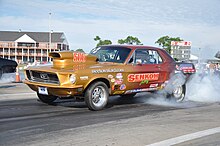Drag racing
This article needs additional citations for verification. (November 2007) |
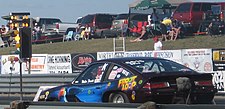
Drag racing is a competition in which specially prepared automobiles or motorcycles compete, usually two at a time, to be first to cross a set finish line. The race follows a straight course from a standing start over a measured distance, most commonly ¼ mile (1,320 ft (400 m)*), with a shorter 1,000 ft (300 m) for some Top Fuel dragsters and funny cars, while 660 ft (200 m) (1/8 mi) is also popular in some circles. Electronic timing and speed sensing systems have been used to record race results since the 1960s. The faster vehicles need a parachute to slow down, an innovation credited (indirectly) to cartoonist Tom Medley.[1]
Basics of drag racing

Before each race (also known as a pass), each driver is allowed to perform a burnout, which heats the driving tires and lays rubber down at the beginning of the track, improving traction. Each driver then lines up (or stages) at the starting line. Races are started electronically by a system known as a Christmas tree. The Christmas tree consists of a column of six lights for each driver/lane, one blue, then three amber, one green, and one red, connected to light beams on the track. The first, a split blue open circle, is split into two halves. When the first light beam is broken by the vehicle's front tire(s) indicate that the driver has pre-staged (approximately 7 inches (180 mm) from the starting line), lights the first half of the blue circle, and then staged (at the starting line), which lights up the second half of the blue circle, and also the corresponding bar in the middle of that circle.[2] [3] Below the blue "staged" light are three large amber lights, a green light, and a red light.
Once the first competitor trips the staged beam, the tree is automatically activated, and the opponent will have up to seven seconds to stage or a red light and automatic timed-out disqualification occurs instantly. Otherwise, when both drivers are staged the tree will start the race up to 8.3 seconds after the race is staged, with the time randomly selected by the Autostart system, which causes the three large amber lights to illuminate, followed by the green one. There are two standard light sequences: either the three amber lights flash simultaneously, followed 0.4 seconds later by the green light (a Pro tree), or the amber lights in sequence from top to bottom, 0.5 seconds apart, followed 0.5 seconds later by the green light (a Sportsman tree, or full tree). If the front tires leaves from a stage beam (stage and pre-stage lights both turned off) before the green light illuminates, the red light for that driver's lane illuminates instead, indicating disqualification (unless a more serious violation occurs). Once a driver commits a red-light foul (also known as redlighting), the other driver can also commit a foul start by leaving the line too early but still win, having left later. The green light automatically is illuminated on the opposite side of the red-lightning driver. Should both drivers leave after the green light illuminates, the one leaving first is said to have a holeshot advantage.
The winner is the first vehicle to cross the finish line (and therefore the driver with the lowest total reaction time and elapsed time). The elapsed time is a measure of performance only; it does not necessarily determine the winner. Because elapsed time does not include reaction time and each lane is timed individually, a car with a slower elapsed time can actually win if that driver's holeshot advantage exceeds the elapsed time difference. In heads-up racing, this is known as a holeshot win.[4]
Several measurements are taken for each race: reaction time, elapsed time, and speed. Reaction time is the period from the green light illuminating to the vehicle leaving the starting line. Elapsed time is the period from the vehicle leaving the starting line to crossing the finish line. Speed is measured through a speed trap covering the final 66 feet (20 m) to the finish line, indicating the approximate maximum speed of the vehicle during the run.
In the standard racing format, the losing car and driver are removed from the contest, while the winner goes on to race other winners, until only one is left.
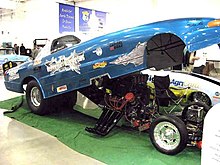
Racing organization


North America
The National Hot Rod Association (NHRA) oversees the majority of drag racing events in North America. The next largest organization, Feld Entertainment's International Hot Rod Association (IHRA), is about one-third the size of NHRA. Nearly all drag strips are associated with one sanctioning body or the other. The NHRA is more popular with large, 1/4-mile [1,320 feet (402 m)] nationally recognized tracks (although the two fuel classes have 1,000 feet (305 m) races to reduce top speeds due to safety concerns), while the IHRA is a favorite of smaller 1/8-mile [660 feet (201 m)] local tracks (and offers selected races on their national tour under the 1/8-mile format). One reason for this (among others) is the IHRA is less restrictive in its rules, such as rules on nitrous oxide (legal in Pro Modified) and oversized engines (no 500-cubic-inch (8.2 L) restriction in the IHRA's Pro Stock category) and less expensive to be associated.
Besides NHRA and IHRA, there are niche organizations for muscle cars and nostalgia vehicles. The National Electric Drag Racing Association (NEDRA) races electric vehicles against high performance gasoline-powered vehicles such as Dodge Vipers or classic muscle cars in 1/4 and 1/8 mile races. The current electric drag racing record is [3] 6.940 seconds at 201.37 mph for a quarter mile. Another niche organization is the VWDRC which run a VW-only championship with vehicles running under 7 seconds.
Prior to the founding of the NHRA and IHRA, smaller organizations sanctioned drag racing in the early years. The first commercially sanctioned drag race on the East Coast was reputed to have been held at Longview Speedway (now Old Dominion Speedway) in Manassas, Virginia. Old Dominion Speedway is currently sanctioned by the SBRA (Southern Bracket Racing Association).
In the midwest, there are several small organizations that have been active in drag racing for several years. One that is notable and well established is Nostalgia Pro Comp Association. They feature old school dragsters and muscle cars, under numerous classes to choose from. The majority of the tracks they race are 1/8-mile and 1/4-mile.
Drag racing is permitted on Main Street in Worcester, Massachusetts during the New England Summer Nationals.
United Kingdom
This section needs expansion. You can help by adding to it. (December 2009) |
The British Hot Rod Association (BHRA) was established in 1960, with the intent of unifying local clubs and holding organised Drag Races at disused airfields like Duxford and Graveley.[5] Santa Pod Raceway, in Northamptonshire, England, opened at Easter in 1966.
Australia
This section needs expansion. You can help by adding to it. (August 2012) |
The first Australian Nationals event was run in 1965 at Riverside raceway, near Melbourne. The Australian National Drag Racing Association (ANDRA) was established in 1973, and today they claim they are the "best in the world outside the United States".[6] ANDRA sanctions races throughout Australia and throughout the year at all levels, from Junior Dragster to Top Fuel.
The ANDRA Pro Series is for professional drivers and riders and includes Top Fuel, Top Alcohol, Top Doorslammer (similar to the USA Pro Modified class), Pro Stock (using 400 cubic inch engines), Top Bike and Pro Stock Motorcycle.
2012 ANDRA Pro Series National Champions: [6] Top Fuel: Darren Morgan [(Darren Morgan Racing)] (2012, 2011, 2005) [7] Top Alcohol: Gary Phillips (2012, 2010, 2009, 2005, 2004, 2003, 2001, 2000, 1999, 1998, 1997, 1996, 1995, 1992, 1991) Top Doorslamer: John Zappia (2012, 2011, 2010, 2009, 2008) Top Bike: Chris Matheson (2012, 2011, 2010) Pro Stock: Michael Ali (2012) Pro Stock Motorcycle: Locky Ireland (2012)
The Rocket Allstars Racing Series is for sportsman drivers and riders and includes Competition, Super Stock, Super Compact, Competition Bike, Supercharged Outlaws, Modified, Super Sedan, Modified Bike, Super Street and Junior Dragster.
Broadcasting is provided on SBS Speedweek and Speed Channel.
Europe
This section needs expansion. You can help by adding to it. (December 2009) |
Drag racing was imported to Europe by American NATO troops during the Cold War.[8] Races were held in West Germany beginning in the 1960s at the airbases at Ramstein and Sembach.[9]
South America
This section needs expansion. You can help by adding to it. (September 2011) |
Organized drag racing in Colombia is Club G3's responsibility, which is a private organization. The events take part at Autódromo de Tocancipá.
South Asia
This section needs expansion. You can help by adding to it. (December 2009) |
Organized drag racing is rapidly growing in India. Autocar India organised the country's first drag race meet in Mumbai in 2002.[10]
Drag racing is also gaining popularity in Pakistan, with private organizations organizing such events. The Bahria Town housing project recently organized a drag racing event in Rawalpindi, with the help of some of the country's best drivers.[11]
South Africa
Drag racing is an established sport in South Africa, with a number of strips around the country including Tarlton International Raceway and ODI Raceway. Drag racing is controlled by Motorsport South Africa and all drivers are required to hold a valid Motorsport South Africa license.[12] Drivers can compete in a number of categories including Top Eliminator, Senior Eliminator, Super Competition Eliminator, Competition Eliminator, Pro Street Bikes, Superbike Eliminator, Supersport Shootout (motorcycle), Street Modified, and Factory Stock.[12]
Classes
This section contains an unencyclopedic or excessive gallery of images. |

There are hundreds of classes in drag racing, each with different requirements and restrictions on things such as weight, engine size, body style, modifications, and many others. NHRA and IHRA share some of these classes, but many are solely used by one sanctioning body or the other. The NHRA boasts over 200 classes, while the IHRA has fewer. Some IHRA classes have multiple sub-classes in them to differentiate by engine components and other features. There is even a class for aspiring youngsters, Junior Dragster, which typically uses an eighth-mile, also favored by VW racers.
In 1997, the FIA (cars) and UEM (bikes) began sanctioning drag racing in Europe with a fully established European Drag Racing Championship, in cooperation (and rules compliance) with NHRA. The major European drag strips include Santa Pod Raceway in Podington, England; Alastaro Circuit, Finland; Mantorp Park, Sweden; Gardermoen Raceway, Norway and the Hockenheimring in Germany. The major difference is the nitro-class distance, which is 300 meters at some tracks, although the NHRA and FIA are likely to discuss the distance change in the future.

There are currently only 5 pro classes in North America, which are:

- Top Fuel Dragster (TF/D). The rail dragsters, or "diggers", are the fastest class. Among the fastest-accelerating machines in the world, these cars can cover the dragstrip in less than 3.8 seconds and record trap speeds over 325 mph. Top Fuel cars are 25 feet long and weigh 2,320 pounds in race-ready trim. Methanol fuel mixed with up to 90% nitromethane is used.
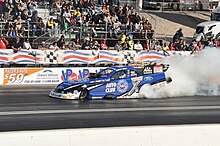
- Top Fuel Funny Car (TF/FC) Similar to their Top Fuel counterparts but with a shorter wheelbase and a carbon-fiber body that loosely resembles a production-based automobile, Funny Cars, or “floppers,” routinely run in the 4.0s and can exceed 315 mph.
- Pro Modified (Pro Mod) Some engine restrictions, very high power. Cars can run superchargers, turbochargers, or nitrous oxide. Cars running blowers are limited to 527 cubic inches (8.6 L) while cars with nitrous can run up to 740 cubic inches (12.1 L).

- Pro Stock (NHRA, MMPSA) Often called “factory hot rods” because of their resemblance to production-based cars (and because they must maintain a relatively stock appearance), commonly called "doorslammers", Pro Stockers can record quarter-mile times in the 6.4 second range, and speeds over 210 mph. They can rev to more than 10,500 rpm and make in excess of 1,300 horsepower. NHRA engines can be no more than 500-cubic-inch (8.2 L) displacement while MMPSA cars can run a maximum of 820 cubic inches (13.4 L) (called "Mountain Motors"). Both classes require the motors to be naturally aspirated.
- Pro Stock Bike (NHRA and ANDRA) These highly modified vehicles, which can run under 6.8 seconds at more than 195 mph, feature a purpose-built tube chassis and a lightweight, aerodynamically enhanced replica of original bodywork.
In addition to the professional classes, these are some other popular classes:
- Top Alcohol Dragster (TA/D) Top Alcohol Dragsters resemble Top Fuelers, but have significant differences. They may use a supercharged methanol-burning engine or an injected nitromethane combination. They can run in the 5.1s at more than 280 mph.
- Top Alcohol Funny Car (TA/FC). Similar in physical appearance to their nitro-burning Funny Car counterparts, Top Alcohol Funny Cars are restricted to the use of methanol fuel and have three-speed transmissions. They can run in the 5.4s at more than 265 mph. In the IHRA, Alcohol Funny Car is the fifh pro category, replacing NHRA's Pro Stock Bike.

- Competition Eliminator This is the NHRA class with the most variety. Each its 88 sections is assigned an index based on what a well-built car should run, and races are handicapped according to those indexes.
- Super Comp/Quick Rod The quickest of the heads-up Super classes (8.90 index) is composed primarily of dragsters. Most cars are capable of running well under the index but use electronic aids to run close to it without breaking out.
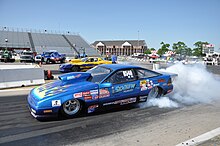
- Super Gas/Super Rod Super Gas entries, which run on a 9.90 index, are primarily full-bodied cars and street roadsters. No dragsters or altereds are permitted. As in Super Comp, competitors use electronic aids to run as close to the class standard without going under.
- Super Street/Hot Rod Racers compete on a fixed 10.90 index. All vehicles must be full-bodied cars and weigh no less than 2,800 pounds except for six-cylinder cars (2,000) and four-cylinder and rotary-powered cars (1,200). Engine and chassis modifications are virtually unlimited.
Super Street Mustang

- Super Stock Super Stock vehicles resemble ordinary passenger cars, but are actually heavily modified. Entries are classified using factory shipping weight and horsepower and compete on indexes. The breakout rule is enforced.
- Stock Stock cars are similar to Super Stockers, but rules regarding everything from engine modifications to body alterations are much stricter. Virtually any car is eligible to compete, and entries are classified using factory shipping weight and horsepower.
- Top Sportsman (NHRA and IHRA) Competitors in these full-bodied entries may choose their own dial for eliminations, generally from 6.00 to 7.99 seconds. Full Tree starts are used, and the breakout rule is enforced. Cars can run in the sixes at more than 200 mph.

- Top Dragster (NHRA and IHRA) Competitors in these open-wheel entries may choose their own dial for eliminations, generally from 6.00 to 7.70 seconds. Full Tree starts are used, and the breakout rule is enforced. Cars can run in the sixes at more than 200 mph. Cars can run any combination of motor: blown, turbo, nitrous or just all motor,
- Top Fuel Funny Bike (high performance 5 second bikes)
- NHRA and ANDRA Summit Racing series Super Pro, Pro, and bike.
- Junior Dragster (racers between the ages of 8 and 18 may race a half scale version of the sport's fastest car, Top Fuel Dragster. Juniors run as following: 12.90-slower for 8-9 year olds, 10-12 year olds at 8.90, and 13-18 year olds 7.90 and slower at a top speed of 85 mph). These cars race at 1/8 mile or 1/16 mile.
Jr.Dragsters Racing - NHRA new class for Juniors is JR COMP running 6.90s at a top speed of 110 miles per hour (180 km/h) (1/8 mile or 1/16 mile).
A complete listing of all classes can be found on the respective NHRA and IHRA official websites.
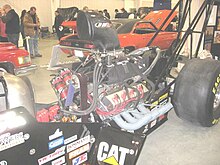
In the FIA European Drag Racing Championships, a different structure of professional categories is used with Top Fuel Dragster (with a 90% nitromethane mix), Top Methanol (Alcohol) Dragster, Top Methanol (Alcohol) Funny Car, Pro Stock, and Pro Modified running as professional championships as well as FIA specifications published for Fuel Funny Car although this does not run as a championship.
The UEM also has a different structure of professional categories with Top Fuel Bike, Super Twin Top Fuel Bike, and Pro Stock Bike contested, leaving the entire European series with a total of 8 professional categories.
To allow different cars to compete against each other, some competitions are raced on a handicap basis, with faster cars delayed on the start line enough to theoretically even things up with the slower car. This may be based on rule differences between the cars in stock, super stock, and modified classes, or on a competitor's chosen "dial-in" in bracket racing.
A "dial-in" is a time the driver estimates it will take his or her car to cross the finish line, and is generally displayed on one or more windows so the starter can adjust the starting lights on the tree accordingly. The slower car will then get a head start equal to the difference in the two dial-ins, so if both cars perform perfectly, they would cross the finish line dead even. If either car goes faster than its dial-in (called breaking out), it is disqualified regardless of who has the lower elapsed time; if both cars break out, the one who breaks out by the smallest amount wins. However, if a driver had jump-started (red light) or crossed a boundary line, both violations override any break out (except in some classes with an absolute break out rule such as Junior classes). This eliminates any advantage from putting a slower time on the windshield to get a head start. The effect of the bracket racing rules is to place a premium on consistency of performance of the driver and car rather than on raw speed, in that victory goes to the driver able to precisely predict elapsed time, whether it is fast or slow. This in turn makes victory much less dependent on large infusions of money, and more dependent on skill. Therefore, bracket racing is popular with casual weekend racers. Many of these recreational racers will drive their vehicles to the track, race them, and then simply drive them home. Most tracks do not host national events every week, and on the interim weekends host local casual and weekend racers. Organizationally, however, the tracks are run according to the rules of either the NHRA or the IHRA (for the most part). Even street vehicles must pass a safety inspection prior to being allowed to race.
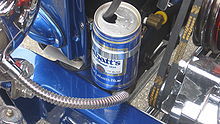
Historic cars
- 1954 — first slingshot, built by Mickey Thompson.[13]
- 1962 — the Greer-Black–Prudhomme digger, with the best win record in NHRA history.[13]
- 1966 — Eliminator I, the first true Funny Car, built by the Logge brothers[13]
- 1971 — Swamp Rat XIV (or Swamp Rat 1-R), first rear-engined dragster, built by Don Garlits;[14] Ed Donovan introduces the 417 Donovan hemi, an aluminum copy of the Chrysler[15]
- 1974 — first tube chassis Pro Stock car, Bill Jenkins' '72 Vega.[16]
- 1986 — Swamp Rat XXX, first streamlined dragster, built by Don Garlits.[17]
Glossary
- Back half—distance from the 1/8 mile mark to the 1/4 mile mark of the track.
- Beam—starting line electric eye controlling prestaged and staged lights.
- Bottle—nitrous system; also known as[citation needed] the jug.
- Blow—supercharge; wreck. Said of an engine.
- Blower—supercharger (occasionally turbocharger); in '90s, generally grouped as "power adder" with turbocharger and nitrous
- Blown—supercharged; wrecked. Said of an engine.
- Blowover—flipping of a car, due to air under car lifting front wheels. Commonly suffered by dragsters
- Breakout—running quicker than dial-in; also "breaking out." Grounds for disqualification if opponent does not commit a foul start or cross boundary lines. Also known as bustout.[citation needed]
- Bulb(ed)[citation needed]—jump(ed) the start, left before tree turned green. This is a loss unless the opponent suffers a more serious foul.
- Burnout—performed to heat the tires up for better traction
- Christmas tree (or tree)—lights used to start a race in addition to showing starting violations
- DA—density altitude; a reference to qualities in the air.
- Dial-in (bracket racing)—estimated of expected e.t. for a pass, set before starting, used for handicapping the start
- Dope—(Southern U.S.) car using nitrous or propane injection on diesels[citation needed]
- Digger—dragster (as distinct from a bodied car or flopper)[18]
- First or worst[citation needed]-if both drivers commit a foul, the driver who commits the foul first loses, unless it is two separate fouls, where the loser is the driver who committed the worse foul (lane violation is worse than foul start, and failure to participate in a post-run inspection is worst).
- Flopper—Funny Car, short for "fender flopper."[citation needed] Coined by dragster crews in the late 1960s to separate Funny Cars, which had fiberglass bodies with fenders, from dragsters. Erroneously attributed to flip-top bodies of Funny Cars.
- Fuel—mix of methanol and nitromethane ("pop," nitro); race class using it
- Fueler—any car running fuel or in Fuel class (most often, TFD or TF/FC)
- Grenade—wreck an engine (the engine "grenaded") due to internal failure. Distinct from "popping a blower".
- Heads-up racing—where both drivers leave at the same time. Used in all professional ("pro") classes.
- Holeshot—getting a significant advantage off the starting line. The other driver gets "holeshotted" or "left at the tree". A "holeshot win" is any win in a heads-up class where a slower car beats a faster car because of better reaction time.
- Hook up—good traction between tires and track resulting in increased acceleration and reduced slipping or smoking of tires.
- James Bond[citation needed]—driver's reaction time (when he leaves the start line) is seven thousands of a second after the green light (.007). A "James Bond Red" is a reaction time of -.007 seconds (red light), which is disqualification unless the opponent commits a more serious violation.
- Kit—turbo or nitrous kit[citation needed]
- Lit the tires—lost traction, causing burning rubber
- Meth—methanol injection[citation needed] used in conjunction with gasoline (non-leaded pump)
- Mill—any internal combustion engine used in a drag car
- Nitro—nitromethane (sometimes incorrectly used to refer to nitrous oxide[citation needed])
- Nitrous—nitrous oxide system; the gas used in such a system
- Overdrive—ratio between the revolutions of the supercharger to the revolutions of the engine, controlling amount of boost; see underdrive
- Oildown—when a car's engine or lubrication breaks during a run, leaving a streak of oil and other fluids on the track. This is punishable by fines, point penalties, and/or suspension.
- Pedalling—working the throttle to avoid lighting the tires, or as a way to sandbag; "pedalled" it, had to "pedal" it
- Pro tree—timing lights which flash all three yellow lights simultaneously, and after four tenths of a second, turn green.
- Put on the trailer—lost (got "put on the trailer") or won (put the other driver on the trailer). From the obvious, losing drivers trailer their cars home.
- Quick 8 (Q8)—quickest eight cars in a defined race. Rules appear to can differ per location/race.
- Rail—dragster (as distinct from bodied car or flopper). From the exposed frame rails of early cars.
- Redlight(ed)—jump(ed) the start, left before tree turned green. This is a loss unless the opponent suffers a more serious foul.
- Sandbagging—releasing the throttle or using the brakes at the end of the track during a bracket race after dialing a purposely slow time. Considered a dirty trick or tantamount to cheating in amateur classes.
- Scattershield—metal sheet protecting driver in case of transmission failure[19]
- Slapper bar—traction bar
- Slicks—rear tires with no tread pattern and softer rubber compound, for increased traction
- Slingshot—early front-engined dragster, named for the driving position behind the rear wheels (erroneously attributed to launch speed)
- Standard tree—timing lights which flash in sequence five tenths of a second between each yellow light before turning green. Traditional form, before introduction of pro tree.
- Struck the tires—loss of traction, causing them to smoke[citation needed]
- Throw a belt—losing the drive belt connecting the engine's crankshaft to the supercharger
- Top end—finish line of strip; high part of engine's rev band.
- Traction bars—rear struts fixed to rear axle to keep rear axle from twisting, causing wheel hop and loss of traction; slapper bars.
- Trap(s)—the 20 meter (66 ft) timing lights at top end of race track to measure speed & E.T.
- Trap speed—speed measured by the speed trap near the finish line, indicating maximum speed reached in a run
- Wheel hop—violent shaking of the car as the tires lose and regain traction in quick succession.
- Wheelie bars—rear struts fixed to rear axle, which protrude out to rear of car to help prevent car's front from raising too high or flipping over on launch.
See also
- Australian National Drag Racing Association (ANDRA)
- Electric dragbike
- Electric dragster
- Jet dragster
- National Hot Rod Association (NHRA)
- Nostalgia drag racing
- Rocket dragster
- Santa Ana Drags
References
- ^ Medley's character, 'Stroker' McGurk, displayed a 'chute in a cartoon in Hot Rod. Rod Action, 2/85, p.32.
- ^ NHRA.com Drag Racing Basics
- ^ [1] New Tree implemented for NHRA VisitMyrtleBeach.com Four-Wide Nationals (but the tree, with just the two middle lights, was adopted permanently by the next round in May 2011)
- ^ "NHRA Glossary". NHRA. Retrieved August 11, 2011.
- ^ "History Of Drag Racing In The UK". trakbytes.co.uk.
- ^ a b Australian National Drag Racing Association ANDRA History Cite error: The named reference "andra" was defined multiple times with different content (see the help page).
- ^ [2]
- ^ "History". francedrag.com.
{{cite web}}: Unknown parameter|en&u=ignored (help) - ^ "Drag racing history in Germany". dragracinghistory.de.
{{cite web}}: Unknown parameter|en&u=ignored (help) - ^ The Telegraph, Calcutta, "Men in Drag"
- ^ The News, Islamabad, "Car Drag race"
- ^ a b "2010 MSA Drag Racing Handbook" (PDF). Retrieved 31 October 2010.
- ^ Hot Rod, 12/86, p.28.
- ^ Street Rodder, 7/94, p.144.
- ^ Super Chevy, 5/94, p.16.
- ^ Hot Rod, 12/86, p.24; Smithsonian Institution
- ^ Emmons, Don, "R&C Modelrama" in Rod & Custom, 9/00, p.147.
- ^ Its invention is credited to Vic King and Pete Wolley for their X/Gas digger in 1959. Dain Gingerelli, "Midnight Oil!" in American Rodder, 6/94, p.81.
- Robert C. Post. High Performance: The Culture and Technology of Drag Racing, 1950 - 2000. Johns Hopkins University Press, revised edition 2001.
External links
![]() Media related to Drag racing at Wikimedia Commons
Media related to Drag racing at Wikimedia Commons
- Australian National Drag Racing Association (ANDRA)
- European Championship Drag Racing (FIA/UEM)
- National Hot Rod Association (NHRA)
- International Hot Rod Association (IHRA)
- Pro Racing Association - Championship Volkswagen Drag Racing
- Drag Racing News, Cars & Events from around the world
- Drag Racing Forum, Race Cars & Racing Events from around the world

